Toxic anthropogenic pollutants reach the deepest ocean on Earth
Affiliations | Corresponding Author | Cite as | Funding information- Share this article





Article views:6,280Cumulative count of HTML views and PDF downloads.
- Download Citation
- Rights & Permissions
top
Abstract
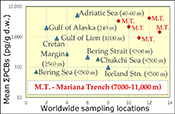
Figures and Tables
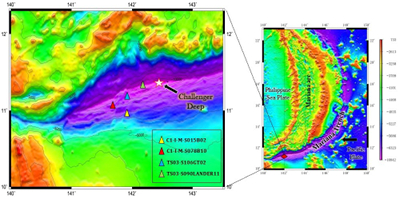 Figure 1 Sampling location map of Mariana Trench sediments. | 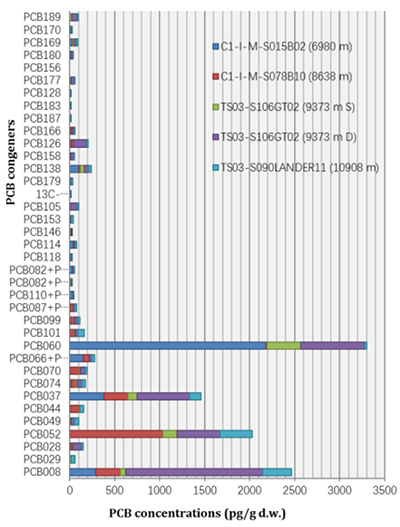 Figure 2 Concentrations of PCB congeners (pg/g d.w.) for different sampling locations at various water depths, as represented by coloured stacked bars. Refer to Table S-2 for details. | 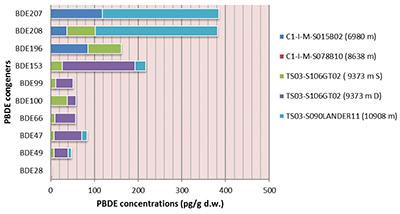 Figure 3 Concentrations of PBDE congeners (pg/g d.w.) for different sampling locations at various water depths, as represented by coloured stacked bars. Refer to Table S-3 for details. | 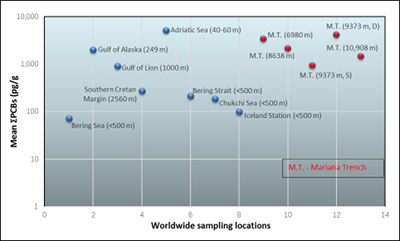 Figure 4 Comparison of ∑PCBs concentrations in the Mariana Trench sediments with other worldwide marine surface water sediments. Figures in brackets indicate water depth. |
| Figure 1 | Figure 2 | Figure 3 | Figure 4 |
top
Letter
The deep ocean arguably acts as the largest potential sink for discarded pollutants (Dachs et al., 2002
Dachs, J., Lohmann, R., Ockenden, W.A., Mejanelle, L., Eisenreich, S.J., Jones, K.C. (2002) Oceanic biogeochemical controls on global dynamics of persistent organic pollutants. Environmental Science and Technology 36, 4229-4237.
). However, the hadal zone (~6000 to 11000 m deep), which represents the deepest ocean on Earth, has largely been unexplored due to its remoteness. Of all the toxic anthropogenic pollutants damaging the oceans, persistent organic pollutants (POPs) are of particular concern due to their robust residence time in the environment (Kukučka et al., 2015Kukučka, P., Audy, O., Kohoutek, J., Holt, E., Kalábová, T., Holoubek, I., Klánová, J. (2015) Source identification, spatio-temporal distribution and ecological risk of persistent organic pollutants in sediments from the upper Danube catchment. Chemosphere 138, 777-783.
), global transport through atmospheric and oceanic currents (Wania and Mackay, 1996Wania, F., Mackay, D. (1996) Tracking the distribution of persistent organic pollutants. Environmental Science and Technology 30, 390A-396A.
), and their ability to bioaccumulate in marine foodwebs (Lohmann et al., 2007Lohmann, R., Breivik, K., Dachs, J., Muir, D. (2007) Global fate of POPs: current and future research directions. Environmental Pollution 150, 150-165.
), resulting in organism endocrine disruption (Rhind, 2012Rhind, S.M. (2012) Anthropogenic pollutants- an insidious threat to animal health and productivity? Acta Veterinaria Scandinavica 54, S2.
) and other adverse health effects. Studies revealing presence of POPs in surface to deep marine sediments are plentiful (e.g., Iwata et al., 1994Iwata, H., Tanabe, S., Aramoto, M., Sakai, N., Tatsukawa, R. (1994) Persistent organochlorine residues in sediments from the Chukchi Sea, Bering Sea and Gulf of Alaska. Marine Pollution Bulletin 28, 746-753.
; Ma et al., 2015Ma, Y., Halsall, C.J., Crosse, J.D., Graf, C., Cai, M., He, J., Gao, G., Jones, K. (2015) Persistent organic pollutants in ocean sediments from the North Pacific to the Arctic Ocean. Journal of Geophysical Research: Oceans 120, 2723-2735.
; Combi et al., 2016Combi, T., Miserocchi, S., Langone, L., Guerra, R. (2016) Polychlorinated biphenyls (PCBs) in sediments from the western Adriatic Sea: Sources, historical trends and inventories. Science of the Total Environment 562, 580-587.
; Neira et al., 2018Neira, C., Vales, M., Mendoza, G., Hoh, E., Levin, L.A. (2018) Polychlorinated biphenyls (PCBs) in recreational marina sediments of San Diego Bay, southern California. Marine Pollution Bulletin 126, 204-214.
), but none of them probed beyond the continental shelf area, leaving the real “depth” of the oceans practically unexplored. In a latest study, Jamieson et al. (2017)Jamieson, A.J., Malkocs, T., Piertney, S.B., Fujii, T., Zhang, Z. (2017) Bioaccumulation of persistent organic pollutants in the deepest ocean fauna. Nature Ecology and Evolution 1, 0051.
reported high concentrations of POPs in endemic amphipod fauna from the Mariana and Kermadec Trenches. The signature of these pollutants through bioaccumulation could, however, be markedly different from that residing in the sediments.The Mariana Trench is located in the western Pacific Ocean, where the Pacific Plate subducts beneath the Mariana and Philippine Sea Plates at convergence rates of 4–8 cm/yr. The southern Mariana Trench encloses the deepest point on the Earth's surface-the Challenger Deep, which is 11034 m down, and 2 km deeper than the average depth along the axis of the Mariana Trench (Fujioka et al., 2002
Fujioka, K., Okino, K., Kanamatsu, T., Ohara, Y. (2002) Morphology and origin of the Challenger Deep in the Southern Mariana Trench. Geophysical Research Letters 29, doi: 10.1029/2001GL013595.
).We detected polychlorinated biphenyls (PCBs) and polybrominated diphenyl ethers (PBDEs) in five sediment samples recovered from the southern Mariana Trench at ocean depths of 6980 m (C1-I-M-S015B02), 8638 m (C1-I-M-S078B10), 9373 m (TS03-S106GT02 (S) and TS03-S106GT02 (D) for top and bottom surface of the core respectively), and 10908 m (TS03-S090LANDER11), (Fig. 1), during TS03 Hadal Trench Cruise carried out via R/V Tansuo Yihao on June, 2017 (See Table S-1 for sampling location details).

Figure 1 Sampling location map of Mariana Trench sediments.
The prominent finding was that, 36 PCB and 10 PBDE congeners (Figs. 2 and 3 respectively) were detected. Lower-chlorinated congeners such as CB-8, CB-37, CB-52 and CB-60 were most abundant (refer to Table S-2), and their concentrations ranged from 1460 to 3300 pg/g. For PBDEs, concentrations ranged from 245 (TS03-S106GT102 (S)) to 591 pg/g (TS03-S090LANDER11) (Table S-3). Low and medium weight PBDEs, such as BDE-47 and BDE-153 were more common in the samples. However, higher weight BDEs 207 and 208 were detected in C1-I-M-S015B02 and TS03-S090LANDER11, with high concentrations of 266 and 280 pg/g respectively.

Figure 2 Concentrations of PCB congeners (pg/g d.w.) for different sampling locations at various water depths, as represented by coloured stacked bars. Refer to Table S-2 for details.

Figure 3 Concentrations of PBDE congeners (pg/g d.w.) for different sampling locations at various water depths, as represented by coloured stacked bars. Refer to Table S-3 for details.
∑PCBs (pg/g) concentrations ranged from 931-4195 pg/g dry weight in all five sediment samples. The Mariana sediments showed higher levels of low- and medium-chlorinated PCB congeners. It is noteworthy that no clear trend of ∑PCB variation with water depth was observed (Fig. S-1).
The seven “indicator PCBs” (Table S-4) chosen following the International Council for the Exploration of the Sea (ICES) convention contributed to 22 % of all PCBs. They showed highest Σ7PCBs values at depths of 8638 m and 9373 m. CB-52 was abundant in most of the samples, except in C1-I-M-S015B02, where it was not detected. These PCBs are indicative of lipophilic contaminants, but their concentrations can vary with the contaminated source (Kim et al., 2004
Kim, M.K., Kim, S., Yun, S., Lee, M., Cho, B., Park, J., Son, S, Kim, O. (2004) Comparison of seven indicator PCBs and three coplanar PCBs in beef, pork, and chicken fat. Chemosphere 54, 1533-1538.
). High concentrations of low-chlorinated CBs, such as CB-52 may be from processes using chlorine oxidation; further, high-chlorinated CBs could be decayed to lighter ones by bacterial decomposition (Kim et al., 2004Kim, M.K., Kim, S., Yun, S., Lee, M., Cho, B., Park, J., Son, S, Kim, O. (2004) Comparison of seven indicator PCBs and three coplanar PCBs in beef, pork, and chicken fat. Chemosphere 54, 1533-1538.
). Presence of mid-chlorinated CBs, such as Penta-CB (CB-101) and Hexa-CBs (CB-138 and CB-153) could be related to partitioning of these compounds to particulate organic matter. High-chlorinated PCBs, such as CB-180 possibly came from terrestrial pollution in the form of industrial sewage, or from marine traffic (Hong et al., 2005Hong, S.H., Yim, U.H., Shim, W.J., Oh, J.R. (2005) Congener-specific survey for polychlorinated biphenyls in sediments of industrialized bays in Korea: regional characteristics and pollution sources. Environmental Science and Technology 39, 7380-7388.
). Although no pattern in concentration vs. water depth was evident, deeper trench samples (C1-I-M-S078B10, TS03-S106GT02 (S), TS03-S106GT02 (D), and TS03-S090LANDER11) exhibited higher Σ7PCBs (average 642.2 pg/g) than C1-I-M-S015B02 (129 pg/g) values.Toxic potency of PCBs was assessed by measuring Toxic Equivalence (TEQ) of twelve dioxin-like (dl-) CB congeners (CB-77, 81, 126, 169, 105, 114, 118, 123, 156, 157, 166, and 189) in all the sediment samples (normalised by multiplying their measured concentrations by the appropriate WHO-TEFs) (Table S-5). The respective TEQPCBs express these analyte concentrations as a single number, which is equivalent to toxicity derived exclusively from 2,3,7,8-TCDD. Mariana dl-PCB-TEQ concentrations ranged from 0.650 – 14.9 pg/g (Table S-6), with the highest TEQPCBs recorded at 9373D. Our results are higher than TEQPCBs values from past studies with sediments from shallow water depths, e.g., a semi-industrial area, Asaluyeh Harbor, Iran (0.001-3.4) (Arfaeinia et al., 2017
Arfaeinia, H., Asadgol, Z., Ahmadi, E., Seifi, M., Moradi, M., Dobaradaran, S. (2017) Characteristics, distribution and sources of polychlorinated biphenyls (PCBs) in coastal sediments from the heavily industrialized area of Asalouyeh, Iran. Water Science and Technology 76, 3340-3350.
); marine sediments from Mediterranean Sea, Catalonia, Spain (0.03-24.8) (Eljarrat et al., 2001Eljarrat, E., Caixach, J., Rivera, J. (2001) Toxic potency of non- and mono-ortho PCBs, PCDDs, PCDFs, and PAHs in Northwest Mediterranean sediments (Catalonia, Spain). Environmental Science and Technology 35, 3589-3594.
); or Han River, Korea (0.0118-0.626) (Kim et al., 2009Kim, K.S., Lee, S.C., Kim, K.H., Shim, W.J., Hong, S.H., Choi, K.H., Yoon, J.H., Kim, J.G. (2009) Survey on organochlorine pesticides, PCDD/Fs, dioxin-like PCBs and HCB in sediments from the Han river, Korea. Chemosphere 75, 580-587.
). Surface marine sediments in shallow water are susceptible to organic pollution due to their proximity to industrial areas, as well as from atmospheric interactions. It is however, surprising to witness such contaminants have reached the deepest parts on Earth.Unlike PCBs, concentrations of PBDEs were lower in the Trench samples. To maintain consistency (since PBDEs are presented as mixtures of congeners), and form a comparable dataset, a total of 8 PBDEs (BDE-28, 47, 99, 100, 153, highlighted in blue in Table S-3; BDE-54, 183, and 209 were not detected) were chosen (Zhang et al., 2016
Zhang, Y., Wang, W., Song, J., Ren, Z., Yuan, H., Yan, H., Zhang, J., Pei, Z., He, Z. (2016) Environmental characteristics of polybrominated diphenyl ethers in marine system, with emphasis on marine organisms and sediments. BioMed Research International 2016, Article ID 1317232, 16 pp, doi: 10.1155/2016/1317232.
), which commonly occur in environmental samples. Their concentrations ranged from 36-289 pg/g. Mid-brominated congener BDE-153 was the most abundant, with concentrations ranging fromYogui, G.T., Sericano, J.L. (2009) Polybrominated diphenyl ether flame retardants in the U.S. Marine environment: a review. Environment International 35, 655-666.
), and were found at concentrations ofde Wit, C.Y., (2002) An overview of brominated flame retardants in the environment. Chemosphere 46, 583-624.
) and in Qingdao coastal sea sediments (Pan et al., 2007Pan, J., Yang, Y.-L., Xu, Q., Chen, D.-Z., Xi, D.-L. (2007) PCBs, PCNs and PBDEs in sediments and mussels from Qingdao coastal sea in the frame of current circulations and influence of sewage sludge. Chemosphere 66, 1971-1982.
), China where BDEs 47, 99, and 153 were the most frequently reported congeners. Our results indicate that penta-BDEs could possibly be transported with water in the soluble and particle phases and degradation and fractionation of higher-brominated congeners (such as PBDE 209) may occur during long range transportation. ∑8PBDEs values (rangeKlosterhaus, S.L., Stapleton, H.M., La Guardia, M.J., Greig, D.J. (2012) Brominated and chlorinated flame retardants in San Francisco Bay sediments and wildlife. Environmental International 47, 56-65.
). In China, samples collected from offshore sediment of northern South China Sea, ∑8PBDEs is 0.93 ng/g and from East China Sea it is below 1 ng/g (Liu et al., 2015Liu, L., Li, H., Wang, Z., Liu, R., Zhang, Y., Lin, K. (2015) Insights into spatially and temporally co-occurring polybrominated diphenyl ethers in sediments of the East China Sea, Chemosphere 123, 55-63.
). The salient finding is that PBDEs were detected in the deepest Trench sediments with concentrations lower than, or nearing those of, coastal surface sediments adjacent to industrial areas.We compared the level of ∑PCB concentrations in the Mariana Trench sediments to those reported in past studies at shallower depths (Fig. 4). The overall ∑PCB values from our study (range: 931-4195 pg/g, mean 2424 pg/g) are overwhelmingly higher than those from shallow marine sediments studied in the past (Table S-7); and higher than the world baseline levels for ∑PCBs arising from atmospheric transport found in clean coastal sediments, which is placed at <1 ng/g d.w. (Phillips, 1986
Phillips, D.J.H. (1986) Use of organisms to quantify PCBs in marine and estuarine environments. In: Waid, J.S. (Ed.) PCBs and the Environment Vol. II. CRC Press, Boca Raton, FL., 127-181.
). However, the PCB concentrations in the sediments are markedly lower than those found in endemic amphipod fauna through bioaccumulation from ~7000-10000 m in the Mariana (Jamieson et al., 2017Jamieson, A.J., Malkocs, T., Piertney, S.B., Fujii, T., Zhang, Z. (2017) Bioaccumulation of persistent organic pollutants in the deepest ocean fauna. Nature Ecology and Evolution 1, 0051.
), since these organisms have been known to rapidly locate and consume any particulate organic matter (POM) from surface-derived carrion falls. Further, pollutants can accumulate in the wax esters of capacious guts of larger amphipods, which are used as energy reserves in times of prolonged food deprivation (Lee et al., 2006Lee, R.F., Hagen, W., Kattner, G. (2006) Lipid storage in marine zooplankton. Marine Ecology Progress Series 307, 273-306.
).
Figure 4 Comparison of ∑PCBs concentrations in the Mariana Trench sediments with other worldwide marine surface water sediments. Figures in brackets indicate water depth.
Hadal communities, such as Hirondellidae tend to accumulate along the trench axis, where gravity driven down-slope transport of sediments results in a nutrient-rich environment (Ichino et al., 2015
Ichino, M.C., Clark, M.R., Drazen, J.C., Jamieson, A., Jones, D.O.B., Martin, A.P., Rowden, A.A., Shank, T.M., Yancey, P.H., Ruhl, H.A. (2015) The distribution of benthic biomass in hadal trenches: a modeling approach to investigate the effect of vertical and lateral organic matter transport to the seafloor. Deep-Sea Research I 100, 21-33.
). However deep sea lysianassoid amphipods are also recorded from shallower trench depths of nutrient poor environments, thought to be advantageous due to limited competitive interactions (Blankenship and Levin, 2007Blankenship, L.E., Levin, L.A. (2007) Extreme food webs: foraging strategies and diets of scavenging amphipods from the ocean's deepest 5 km. Limnology Oceanography 52, 1685-1697.
). Post-mortal discharge of pollutants bioaccumulated by these endemic species and stored in the wax esters, or ingestion and faecal release may account for the high concentration of PCBs and PBDEs in the Mariana sediments. In addition, remote trenches encounter seafloor landslides or earthquakes. The funnel-like shape and high fluid dynamics within the Trench favour accumulation of pollutants along the trench axis (Turnewitsch et al., 2014Turnewitsch, R., Falahat, S., Stehlikova, J., Oguri, K., Glud, R.N., Middelboe, M., Kitazato, H., Wenzhoefer, F., Ando, K., Fujio, S. (2014) Recent sediment dynamics in hadal trenches: evidence for the influence of higher-frequency (tidal, near-inertial) fluid dynamics. Deep-Sea Research I Oceanographic Research Papers 90, 125-138.
), associated with these geotectonic events. However, apart from slightly higher organic carbon content in the Challenger Deep (0.3-0.4 %) (Glud et al., 2013Glud, R.N., Wenzhöfer, F., Middelboe, M., Oguri, K., Turnewitch, R., Canfield, D.E., Kitazato, H. (2013) High rates of microbial carbon turnover in sediments in the deepest oceanic trench on Earth. Nature Geoscience 6, 284-288.
), hadal sediments are more depleted in total organic carbon (TOC), often reaching as low as 0.22 % (Luo et al., 2017Luo, M., Gieskes, J., Chen, L., Shu, X., Chen, D. (2017) Provenances, distribution, and accumulation of organic matter in the southern Mariana Trench rim and slope: Implication of carbon cycle and burial in hadal trenches. Marine Geology 386, 98-106.
). Therefore, the dominance of organic matter-associated POPs in deep sea sediments over surface marine sediments seems paradoxical. We suspect that clay minerals may play a major role in the adsorption of contaminant particles in hadal sediments. Due to the lack of available studies, we conducted a preliminary mineralogical investigation of three sediment samples from deepest points by X-ray diffraction (XRD). Our results indicate clay assemblages (illite, nontronite, clinochlore, and gismondine) are abundant in the deepest sediments (Fig. S-2), with their total relative concentrations ranging from 51.8 to 86.5 % in the three samples (Table S-8) A number of possible mechanisms of sorption of POPs with clay minerals are explained in previous studies (e.g., Li et al., 2015Li, Z., Fitzgerald, N.M., Albert, Z., Schnabl, A., Jiang, W.-T. (2015) Contrasting mechanisms of metoprolol uptake on kaolinite and talc. Chemical Engineering Journal 272, 48-57.
). For example, hydrogen bonding is demonstrated to bind polar groups of contaminants and basal oxygen atoms or adsorbed water of clay minerals (Wang et al., 2011Wang, C.J., Li, Z., Jiang, W.T. (2011) Adsorption of ciprofloxacin on 2:1 dioctahedral clay minerals. Applied Clay Science 53, 723–728.
). Binding of POPs in surface or interstitial layers of clays could act towards the agglomeration of pollutants in the hadal sediments. Further, long range transport of these pollutants could be linked to allogenic clays from terrestrial or shallow water origins.The present discovery serves as evidence as to how far man-made pollutants have reached; and any such contamination will have ecological and toxic effects, long-term or ephemeral, depending on the scale of impact. Possibly, there no longer exists “pure land” that can completely be isolated from human activities in the Earth’s ocean. High concentrations of pervasive pollutants in the trench sediments also imply that the Trench is a repository for POPs amplification, which occurs regardless of the source of these toxic anthropogenic pollutants. Certainly, high concentrations of POPs in the deepest ocean sediments are directly affecting hadal ecosystems, considering their persistent nature. The immediate challenge, therefore, is to assess the impact of anthropogenic pollutants reaching or residing in the deepest ocean. More detailed spatial and ecotoxicological studies on trench sediments will better our understanding of effects of POPs and other pervasive pollutants such as microplastics and litter in such environment.
Editor: Eric H. Oelkers
top
References
Arfaeinia, H., Asadgol, Z., Ahmadi, E., Seifi, M., Moradi, M., Dobaradaran, S. (2017) Characteristics, distribution and sources of polychlorinated biphenyls (PCBs) in coastal sediments from the heavily industrialized area of Asalouyeh, Iran. Water Science and Technology 76, 3340-3350.
 Show in context
Show in context Our results are higher than TEQPCBs values from past studies with sediments from shallow water depths, e.g., a semi-industrial area, Asaluyeh Harbor, Iran (0.001-3.4) (Arfaeinia et al., 2017); marine sediments from Mediterranean Sea, Catalonia, Spain (0.03-24.8) (Eljarrat et al., 2001); or Han River, Korea (0.0118-0.626) (Kim et al., 2009).
View in article
Blankenship, L.E., Levin, L.A. (2007) Extreme food webs: foraging strategies and diets of scavenging amphipods from the ocean's deepest 5 km. Limnology Oceanography 52, 1685-1697.
 Show in context
Show in contextHowever deep sea lysianassoid amphipods are also recorded from shallower trench depths of nutrient poor environments, thought to be advantageous due to limited competitive interactions (Blankenship and Levin, 2007).
View in article
Combi, T., Miserocchi, S., Langone, L., Guerra, R. (2016) Polychlorinated biphenyls (PCBs) in sediments from the western Adriatic Sea: Sources, historical trends and inventories. Science of the Total Environment 562, 580-587.
 Show in context
Show in context Studies revealing presence of POPs in surface to deep marine sediments are plentiful (e.g., Iwata et al., 1994; Ma et al., 2015; Combi et al., 2016; Neira et al., 2018), but none of them probed beyond the continental shelf area, leaving the real “depth” of the oceans practically unexplored.
View in article
Dachs, J., Lohmann, R., Ockenden, W.A., Mejanelle, L., Eisenreich, S.J., Jones, K.C. (2002) Oceanic biogeochemical controls on global dynamics of persistent organic pollutants. Environmental Science and Technology 36, 4229-4237.
 Show in context
Show in context The deep ocean arguably acts as the largest potential sink for discarded pollutants (Dachs et al., 2002).
View in article
de Wit, C.Y., (2002) An overview of brominated flame retardants in the environment. Chemosphere 46, 583-624.
 Show in context
Show in context The PBDE congener distribution of Mariana sediments resembles those reported elsewhere in surface marine sediments from Europe (de Wit, 2002) and in Qingdao coastal sea sediments (Pan et al., 2007), China where BDEs 47, 99, and 153 were the most frequently reported congeners.
View in article
Eljarrat, E., Caixach, J., Rivera, J. (2001) Toxic potency of non- and mono-ortho PCBs, PCDDs, PCDFs, and PAHs in Northwest Mediterranean sediments (Catalonia, Spain). Environmental Science and Technology 35, 3589-3594.
 Show in context
Show in context Our results are higher than TEQPCBs values from past studies with sediments from shallow water depths, e.g., a semi-industrial area, Asaluyeh Harbor, Iran (0.001-3.4) (Arfaeinia et al., 2017); marine sediments from Mediterranean Sea, Catalonia, Spain (0.03-24.8) (Eljarrat et al., 2001); or Han River, Korea (0.0118-0.626) (Kim et al., 2009).
View in article
Fujioka, K., Okino, K., Kanamatsu, T., Ohara, Y. (2002) Morphology and origin of the Challenger Deep in the Southern Mariana Trench. Geophysical Research Letters 29, doi: 10.1029/2001GL013595.
 Show in context
Show in contextThe southern Mariana Trench encloses the deepest point on the Earth's surface-the Challenger Deep, which is 11034 m down, and 2 km deeper than the average depth along the axis of the Mariana Trench (Fujioka et al., 2002).
View in article
Glud, R.N., Wenzhöfer, F., Middelboe, M., Oguri, K., Turnewitch, R., Canfield, D.E., Kitazato, H. (2013) High rates of microbial carbon turnover in sediments in the deepest oceanic trench on Earth. Nature Geoscience 6, 284-288.
 Show in context
Show in contextHowever, apart from slightly higher organic carbon content in the Challenger Deep (0.3-0.4 %) (Glud et al., 2013), hadal sediments are more depleted in total organic carbon (TOC), often reaching as low as 0.22 % (Luo et al., 2017).
View in article
Hong, S.H., Yim, U.H., Shim, W.J., Oh, J.R. (2005) Congener-specific survey for polychlorinated biphenyls in sediments of industrialized bays in Korea: regional characteristics and pollution sources. Environmental Science and Technology 39, 7380-7388.
 Show in context
Show in contextHigh-chlorinated PCBs, such as CB-180 possibly came from terrestrial pollution in the form of industrial sewage, or from marine traffic (Hong et al., 2005).
View in article
Ichino, M.C., Clark, M.R., Drazen, J.C., Jamieson, A., Jones, D.O.B., Martin, A.P., Rowden, A.A., Shank, T.M., Yancey, P.H., Ruhl, H.A. (2015) The distribution of benthic biomass in hadal trenches: a modeling approach to investigate the effect of vertical and lateral organic matter transport to the seafloor. Deep-Sea Research I 100, 21-33.
 Show in context
Show in contextHadal communities, such as Hirondellidae tend to accumulate along the trench axis, where gravity driven down-slope transport of sediments results in a nutrient-rich environment (Ichino et al., 2015).
View in article
Iwata, H., Tanabe, S., Aramoto, M., Sakai, N., Tatsukawa, R. (1994) Persistent organochlorine residues in sediments from the Chukchi Sea, Bering Sea and Gulf of Alaska. Marine Pollution Bulletin 28, 746-753.
 Show in context
Show in contextStudies revealing presence of POPs in surface to deep marine sediments are plentiful (e.g., Iwata et al., 1994; Ma et al., 2015; Combi et al., 2016; Neira et al., 2018), but none of them probed beyond the continental shelf area, leaving the real “depth” of the oceans practically unexplored.
View in article
Jamieson, A.J., Malkocs, T., Piertney, S.B., Fujii, T., Zhang, Z. (2017) Bioaccumulation of persistent organic pollutants in the deepest ocean fauna. Nature Ecology and Evolution 1, 0051.
 Show in context
Show in contextIn a latest study, Jamieson et al. (2017) reported high concentrations of POPs in endemic amphipod fauna from the Mariana and Kermadec Trenches.
View in article
However, the PCB concentrations in the sediments are markedly lower than those found in endemic amphipod fauna through bioaccumulation from ~7000-10000 m in the Mariana (Jamieson et al., 2017), since these organisms have been known to rapidly locate and consume any particulate organic matter (POM) from surface-derived carrion falls.
View in article
Kim, K.S., Lee, S.C., Kim, K.H., Shim, W.J., Hong, S.H., Choi, K.H., Yoon, J.H., Kim, J.G. (2009) Survey on organochlorine pesticides, PCDD/Fs, dioxin-like PCBs and HCB in sediments from the Han river, Korea. Chemosphere 75, 580-587.
 Show in context
Show in contextOur results are higher than TEQPCBs values from past studies with sediments from shallow water depths, e.g., a semi-industrial area, Asaluyeh Harbor, Iran (0.001-3.4) (Arfaeinia et al., 2017); marine sediments from Mediterranean Sea, Catalonia, Spain (0.03-24.8) (Eljarrat et al., 2001); or Han River, Korea (0.0118-0.626) (Kim et al., 2009).
View in article
Kim, M.K., Kim, S., Yun, S., Lee, M., Cho, B., Park, J., Son, S, Kim, O. (2004) Comparison of seven indicator PCBs and three coplanar PCBs in beef, pork, and chicken fat. Chemosphere 54, 1533-1538.
 Show in context
Show in context These PCBs are indicative of lipophilic contaminants, but their concentrations can vary with the contaminated source (Kim et al., 2004).
View in article
High concentrations of low-chlorinated CBs, such as CB-52 may be from processes using chlorine oxidation; further, high-chlorinated CBs could be decayed to lighter ones by bacterial decomposition (Kim et al., 2004).
View in article
Klosterhaus, S.L., Stapleton, H.M., La Guardia, M.J., Greig, D.J. (2012) Brominated and chlorinated flame retardants in San Francisco Bay sediments and wildlife. Environmental International 47, 56-65.
 Show in context
Show in contextLooking at the research carried in San Francisco Bay sediments, the ∑8PBDEs in each sample area (Suisun Bay, San Pablo Bay, Central Bay, and South Bay) range from 2.46-5.14 ng/g (Klosterhaus et al., 2012).
View in article
Kukučka, P., Audy, O., Kohoutek, J., Holt, E., Kalábová, T., Holoubek, I., Klánová, J. (2015) Source identification, spatio-temporal distribution and ecological risk of persistent organic pollutants in sediments from the upper Danube catchment. Chemosphere 138, 777-783.
 Show in context
Show in contextOf all the toxic anthropogenic pollutants damaging the oceans, persistent organic pollutants (POPs) are of particular concern due to their robust residence time in the environment (Kukučka et al., 2015), global transport through atmospheric and oceanic currents (Wania and Mackay, 1996), and their ability to bioaccumulate in marine foodwebs (Lohmann et al., 2007), resulting in organism endocrine disruption (Rhind, 2012) and other adverse health effects.
View in article
Lee, R.F., Hagen, W., Kattner, G. (2006) Lipid storage in marine zooplankton. Marine Ecology Progress Series 307, 273-306.
 Show in context
Show in contextFurther, pollutants can accumulate in the wax esters of capacious guts of larger amphipods, which are used as energy reserves in times of prolonged food deprivation (Lee et al., 2006).
View in article
Li, Z., Fitzgerald, N.M., Albert, Z., Schnabl, A., Jiang, W.-T. (2015) Contrasting mechanisms of metoprolol uptake on kaolinite and talc. Chemical Engineering Journal 272, 48-57.
 Show in context
Show in context A number of possible mechanisms of sorption of POPs with clay minerals are explained in previous studies (e.g., Li et al., 2015).
View in article
Liu, L., Li, H., Wang, Z., Liu, R., Zhang, Y., Lin, K. (2015) Insights into spatially and temporally co-occurring polybrominated diphenyl ethers in sediments of the East China Sea, Chemosphere 123, 55-63.
 Show in context
Show in context In China, samples collected from offshore sediment of northern South China Sea, ∑8PBDEs is 0.93 ng/g and from East China Sea it is below 1 ng/g (Liu et al., 2015).
View in article
Lohmann, R., Breivik, K., Dachs, J., Muir, D. (2007) Global fate of POPs: current and future research directions. Environmental Pollution 150, 150-165.
 Show in context
Show in contextOf all the toxic anthropogenic pollutants damaging the oceans, persistent organic pollutants (POPs) are of particular concern due to their robust residence time in the environment (Kukučka et al., 2015), global transport through atmospheric and oceanic currents (Wania and Mackay, 1996), and their ability to bioaccumulate in marine foodwebs (Lohmann et al., 2007), resulting in organism endocrine disruption (Rhind, 2012) and other adverse health effects.
View in article
Luo, M., Gieskes, J., Chen, L., Shu, X., Chen, D. (2017) Provenances, distribution, and accumulation of organic matter in the southern Mariana Trench rim and slope: Implication of carbon cycle and burial in hadal trenches. Marine Geology 386, 98-106.
 Show in context
Show in context However, apart from slightly higher organic carbon content in the Challenger Deep (0.3-0.4 %) (Glud et al., 2013), hadal sediments are more depleted in total organic carbon (TOC), often reaching as low as 0.22 % (Luo et al., 2017).
View in article
Ma, Y., Halsall, C.J., Crosse, J.D., Graf, C., Cai, M., He, J., Gao, G., Jones, K. (2015) Persistent organic pollutants in ocean sediments from the North Pacific to the Arctic Ocean. Journal of Geophysical Research: Oceans 120, 2723-2735.
 Show in context
Show in context Studies revealing presence of POPs in surface to deep marine sediments are plentiful (e.g., Iwata et al., 1994; Ma et al., 2015; Combi et al., 2016; Neira et al., 2018), but none of them probed beyond the continental shelf area, leaving the real “depth” of the oceans practically unexplored.
View in article
Neira, C., Vales, M., Mendoza, G., Hoh, E., Levin, L.A. (2018) Polychlorinated biphenyls (PCBs) in recreational marina sediments of San Diego Bay, southern California. Marine Pollution Bulletin 126, 204-214.
 Show in context
Show in contextStudies revealing presence of POPs in surface to deep marine sediments are plentiful (e.g., Iwata et al., 1994; Ma et al., 2015; Combi et al., 2016; Neira et al., 2018), but none of them probed beyond the continental shelf area, leaving the real “depth” of the oceans practically unexplored.
View in article
Pan, J., Yang, Y.-L., Xu, Q., Chen, D.-Z., Xi, D.-L. (2007) PCBs, PCNs and PBDEs in sediments and mussels from Qingdao coastal sea in the frame of current circulations and influence of sewage sludge. Chemosphere 66, 1971-1982.
 Show in context
Show in contextThe PBDE congener distribution of Mariana sediments resembles those reported elsewhere in surface marine sediments from Europe (de Wit, 2002) and in Qingdao coastal sea sediments (Pan et al., 2007), China where BDEs 47, 99, and 153 were the most frequently reported congeners.
View in article
Phillips, D.J.H. (1986) Use of organisms to quantify PCBs in marine and estuarine environments. In: Waid, J.S. (Ed.) PCBs and the Environment Vol. II. CRC Press, Boca Raton, FL., 127-181.
 Show in context
Show in contextThe overall ∑PCB values from our study (range: 931-4195 pg/g, mean 2424 pg/g) are overwhelmingly higher than those from shallow marine sediments studied in the past (Table S-7); and higher than the world baseline levels for ∑PCBs arising from atmospheric transport found in clean coastal sediments, which is placed at <1 ng/g d.w. (Phillips, 1986).
View in article
Rhind, S.M. (2012) Anthropogenic pollutants- an insidious threat to animal health and productivity? Acta Veterinaria Scandinavica 54, S2.
 Show in context
Show in context Of all the toxic anthropogenic pollutants damaging the oceans, persistent organic pollutants (POPs) are of particular concern due to their robust residence time in the environment (Kukučka et al., 2015), global transport through atmospheric and oceanic currents (Wania and Mackay, 1996), and their ability to bioaccumulate in marine foodwebs (Lohmann et al., 2007), resulting in organism endocrine disruption (Rhind, 2012) and other adverse health effects.
View in article
Turnewitsch, R., Falahat, S., Stehlikova, J., Oguri, K., Glud, R.N., Middelboe, M., Kitazato, H., Wenzhoefer, F., Ando, K., Fujio, S. (2014) Recent sediment dynamics in hadal trenches: evidence for the influence of higher-frequency (tidal, near-inertial) fluid dynamics. Deep-Sea Research I Oceanographic Research Papers 90, 125-138.
 Show in context
Show in context The funnel-like shape and high fluid dynamics within the Trench favour accumulation of pollutants along the trench axis (Turnewitsch et al., 2014), associated with these geotectonic events.
View in article
Wang, C.J., Li, Z., Jiang, W.T. (2011) Adsorption of ciprofloxacin on 2:1 dioctahedral clay minerals. Applied Clay Science 53, 723-728.
 Show in context
Show in context For example, hydrogen bonding is demonstrated to bind polar groups of contaminants and basal oxygen atoms or adsorbed water of clay minerals (Wang et al., 2011).
View in article
Wania, F., Mackay, D. (1996) Tracking the distribution of persistent organic pollutants. Environmental Science and Technology 30, 390A-396A.
 Show in context
Show in contextOf all the toxic anthropogenic pollutants damaging the oceans, persistent organic pollutants (POPs) are of particular concern due to their robust residence time in the environment (Kukučka et al., 2015), global transport through atmospheric and oceanic currents (Wania and Mackay, 1996), and their ability to bioaccumulate in marine foodwebs (Lohmann et al., 2007), resulting in organism endocrine disruption (Rhind, 2012) and other adverse health effects.
View in article
Yogui, G.T., Sericano, J.L. (2009) Polybrominated diphenyl ether flame retardants in the U.S. Marine environment: a review. Environment International 35, 655-666.
 Show in context
Show in contextPenta-BDE mixture components BDE-47 and 99 possibly originated terrestrially from polyurethane foams (Yogui and Sericano, 2009), and were found at concentrations of
Zhang, Y., Wang, W., Song, J., Ren, Z., Yuan, H., Yan, H., Zhang, J., Pei, Z., He, Z. (2016) Environmental characteristics of polybrominated diphenyl ethers in marine system, with emphasis on marine organisms and sediments. BioMed Research International 2016, Article ID 1317232, 16 pp, doi: 10.1155/2016/1317232.
 Show in context
Show in contextTo maintain consistency (since PBDEs are presented as mixtures of congeners), and form a comparable dataset, a total of 8 PBDEs (BDE-28, 47, 99, 100, 153, highlighted in blue in Table S-3; BDE-54, 183, and 209 were not detected) were chosen (Zhang et al., 2016), which commonly occur in environmental samples.
View in article
top
Supplementary Information
The Supplementary Information includes:
- Sampling locations
- Methods
- Tables S-1 to S-8
- Figures S-1 and S-2
- Supplementary Information References
Download the Supplementary Information (PDF).
Figures and Tables
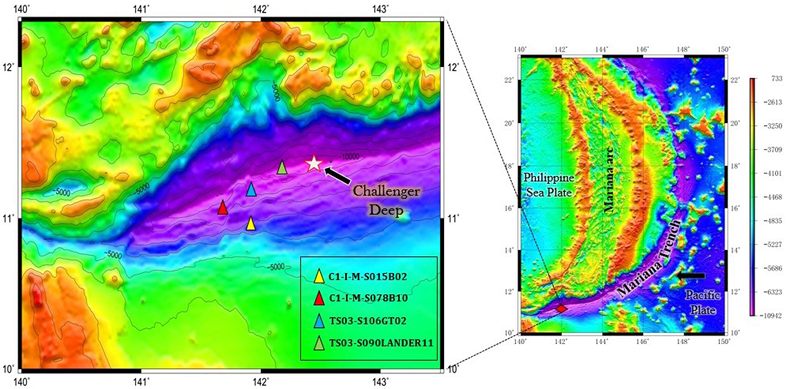
Figure 1 Sampling location map of Mariana Trench sediments.
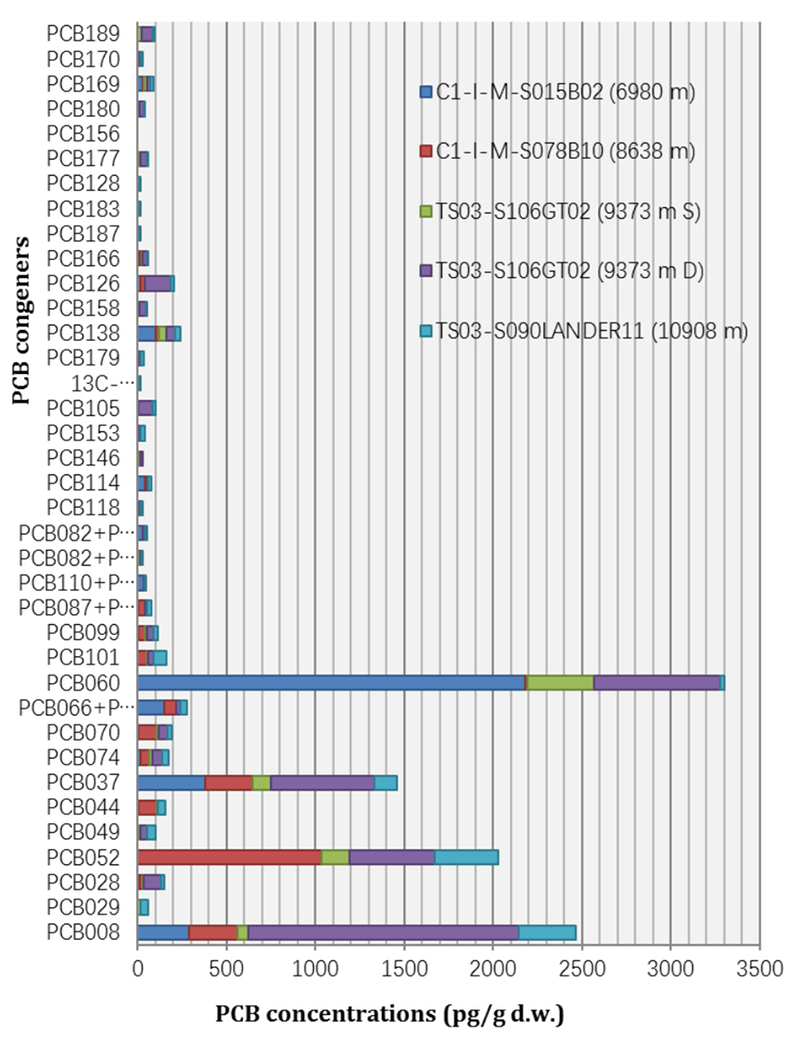
Figure 2 Concentrations of PCB congeners (pg/g d.w.) for different sampling locations at various water depths, as represented by coloured stacked bars. Refer to Table S-2 for details.
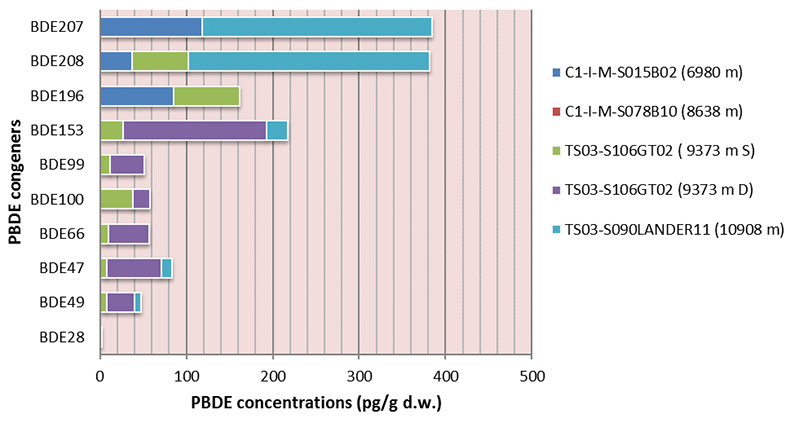
Figure 3 Concentrations of PBDE congeners (pg/g d.w.) for different sampling locations at various water depths, as represented by coloured stacked bars. Refer to Table S-3 for details.
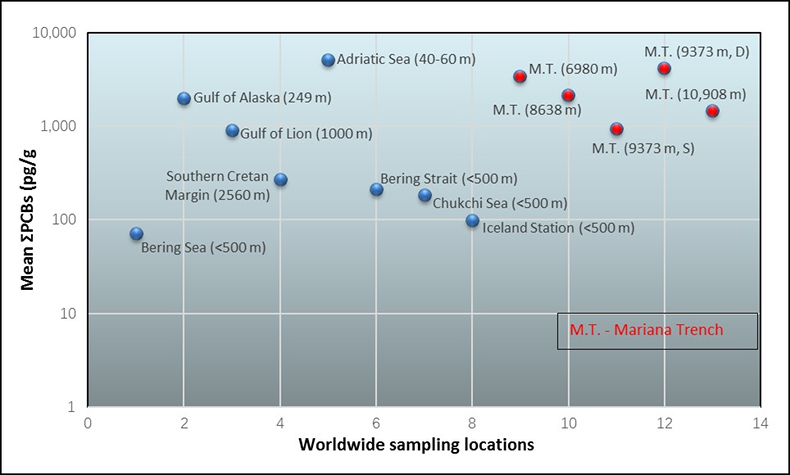
Figure 4 Comparison of ∑PCBs concentrations in the Mariana Trench sediments with other worldwide marine surface water sediments. Figures in brackets indicate water depth.






